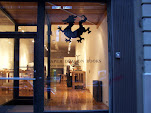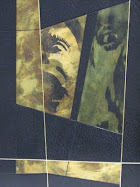I started this project in 2006, and since then have made a lot of boxes. I was aware of the limitations of my skill when I started, and consequently tried to play it safe. The problem with that is first...you don't learn anything, and second, the work can't improve. After the first 30-60 in the first year, it became clear I would have to take risks. There are many examples of improvements I have sought to make over the years, such as learning to hand-letter to an acceptably professional level, and gold tooling in general.
A full account of all the things I've learned and used, and the others that I have discovered myself, such as printing from half tones on leather, I hope to offer up in an article for The Bonefolder online journal later this year. Today I wish to bring to your attention one development which may completely change the way the remaining boxes are made.
 I had been making these boxes using a style of full-leather clamshell I picked up working with my friend and trade-binder Ramon Perdomo-a style which uses the structure published by Scott kellar in '99, and which he attributes to Bill Anthony. It is similar, but with some key differences, which I have detailed in earlier posts, and which you can see in video on the right.
I had been making these boxes using a style of full-leather clamshell I picked up working with my friend and trade-binder Ramon Perdomo-a style which uses the structure published by Scott kellar in '99, and which he attributes to Bill Anthony. It is similar, but with some key differences, which I have detailed in earlier posts, and which you can see in video on the right.
3 months in, I was lucky enough to get some studio time with my first teacher Mark Cockram, when he visited the CBA in NYC that same year. After looking over the boxes, Mark made several helpful suggestions as to how to improve both the structure, and the finishing of the boxes, advice that I would not put into practice until
3 years later.
 One of these tips was an off-the-cuff 5 minute demo of how to improve the initial structure of the box. Mark suggested a strip of board be glued to the edges of the inside of both boards, providing for a similar turn-in to that of the spine, where the leather is turned overed a square vellum core. The resulting "lip", provides these benefits..
One of these tips was an off-the-cuff 5 minute demo of how to improve the initial structure of the box. Mark suggested a strip of board be glued to the edges of the inside of both boards, providing for a similar turn-in to that of the spine, where the leather is turned overed a square vellum core. The resulting "lip", provides these benefits..
1.The extra thickness at both edges,make a tidy recess for the top trays to sit, making sure that they are attached in the correct position, and thereby further ensuring that the box close properly and stand up straight...this is particularly useful on tall slender boxes...please note,that differences of a millimeter in the position of the trays can result in the twisting of the case as it is closed, which will result in a box that leans.
 2. The lip in the same position on the back board of the case, provides for an extra "locking"of the box. This further ensures the box stays straight and adds to dust-proofing the structure, which is always good....
2. The lip in the same position on the back board of the case, provides for an extra "locking"of the box. This further ensures the box stays straight and adds to dust-proofing the structure, which is always good....
3.As this style of box that I have been using is made with "squares", the lip also helps to ensure against possible sagging of the walls and de-laminating of the trays from the case, also enabling you to keep the fabric of the walls away from the bottom of the shelf.
This development, and the different way I make and use the form and joints, make for a very different box...building an existing structure into something different....It is, and it isn't a solander...its a small difference, and a big one...it may not be new, but I've never seen it before.
Mark has recently taught a workshop on the box in the past months and is calling it the "2 tray lipped clamshell"
As I have said, working at the edge of your skill requires that in order to improve you must take risks. Making changes in the production and design of the boxes, when they had been keeping the client happy, has been like jumping from a modest cliff, in that you never know what kind of landing you are going to get...or if you're going to get paid at the end of it.
In most cases, but not all, these improvements have resulted in longer production time, and harder work, but I have managed for the time being to balance this with the client by a marked improvement in areas such as finishing.
I learned a lot from Mark, most of which I am only beginning to understand.
A full account of all the things I've learned and used, and the others that I have discovered myself, such as printing from half tones on leather, I hope to offer up in an article for The Bonefolder online journal later this year. Today I wish to bring to your attention one development which may completely change the way the remaining boxes are made.
 I had been making these boxes using a style of full-leather clamshell I picked up working with my friend and trade-binder Ramon Perdomo-a style which uses the structure published by Scott kellar in '99, and which he attributes to Bill Anthony. It is similar, but with some key differences, which I have detailed in earlier posts, and which you can see in video on the right.
I had been making these boxes using a style of full-leather clamshell I picked up working with my friend and trade-binder Ramon Perdomo-a style which uses the structure published by Scott kellar in '99, and which he attributes to Bill Anthony. It is similar, but with some key differences, which I have detailed in earlier posts, and which you can see in video on the right.3 months in, I was lucky enough to get some studio time with my first teacher Mark Cockram, when he visited the CBA in NYC that same year. After looking over the boxes, Mark made several helpful suggestions as to how to improve both the structure, and the finishing of the boxes, advice that I would not put into practice until
3 years later.
 One of these tips was an off-the-cuff 5 minute demo of how to improve the initial structure of the box. Mark suggested a strip of board be glued to the edges of the inside of both boards, providing for a similar turn-in to that of the spine, where the leather is turned overed a square vellum core. The resulting "lip", provides these benefits..
One of these tips was an off-the-cuff 5 minute demo of how to improve the initial structure of the box. Mark suggested a strip of board be glued to the edges of the inside of both boards, providing for a similar turn-in to that of the spine, where the leather is turned overed a square vellum core. The resulting "lip", provides these benefits..1.The extra thickness at both edges,make a tidy recess for the top trays to sit, making sure that they are attached in the correct position, and thereby further ensuring that the box close properly and stand up straight...this is particularly useful on tall slender boxes...please note,that differences of a millimeter in the position of the trays can result in the twisting of the case as it is closed, which will result in a box that leans.
 2. The lip in the same position on the back board of the case, provides for an extra "locking"of the box. This further ensures the box stays straight and adds to dust-proofing the structure, which is always good....
2. The lip in the same position on the back board of the case, provides for an extra "locking"of the box. This further ensures the box stays straight and adds to dust-proofing the structure, which is always good....3.As this style of box that I have been using is made with "squares", the lip also helps to ensure against possible sagging of the walls and de-laminating of the trays from the case, also enabling you to keep the fabric of the walls away from the bottom of the shelf.
This development, and the different way I make and use the form and joints, make for a very different box...building an existing structure into something different....It is, and it isn't a solander...its a small difference, and a big one...it may not be new, but I've never seen it before.
Mark has recently taught a workshop on the box in the past months and is calling it the "2 tray lipped clamshell"
As I have said, working at the edge of your skill requires that in order to improve you must take risks. Making changes in the production and design of the boxes, when they had been keeping the client happy, has been like jumping from a modest cliff, in that you never know what kind of landing you are going to get...or if you're going to get paid at the end of it.
In most cases, but not all, these improvements have resulted in longer production time, and harder work, but I have managed for the time being to balance this with the client by a marked improvement in areas such as finishing.
I learned a lot from Mark, most of which I am only beginning to understand.









No comments:
Post a Comment